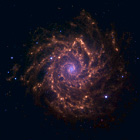|
Astrobiology in SpaceEngine
|
|
| Talisman | Date: Friday, 16.12.2011, 08:23 | Message # 1 |
 Pioneer
Group: Users
 United States
United States
Messages: 409
Status: Offline
| Quote (SpaceEngineer) We need a specialist in astrobiology to make powerful and scientifically-accurate model for life in SE. We have a discussion on Russian forum (try google translator), however, at amateur level. I wold like to start such discussion at this forum!
SpaceEngineer suggested we make a thread about Astrobiology in Space Engine, I think this is a really interesting topic.
Currently it is very basic and randomly calculated from terra's that are within certain parameters, however in the future SpaceEngineer want's to make it much more advanced and intricate.
it would be neat if life could also be calculated for suitable ice words that have calculated liquid insides and such, perhaps even geothermally active desert planets could even have some form of microbiology deep inside the crust, or maybe even have very rare few comets/asteroids that have some form of microbes embedded inside of them (Panspermia).
In the future planets with life should also have a secondary indicator at the end which notes what type of life lives on the planet, for example;
Comfort Terra with life (Microbial, water only) or (Minor mammalia and some microbes) (Semi-intelligent humanoid/mammalls (minor tool using animals such as chimpanzee or crows) ) or (Intelligent humanoid life (similar to us) or (Advanced Intelligent Life) or perhaps even (Machine "life" only on this planet) / (Silicone based organisms)
The possibilities are endless and would make exploring space really fun as you could find a very very wide group of life-types.
I want to know what SpaceEngineer plans on doing, but what do you guys think?

Edited by Talisman - Friday, 16.12.2011, 09:25 |
| |
| |
| naximar | Date: Friday, 16.12.2011, 13:32 | Message # 2 |
|
Observer
Group: Users
 Croatia
Croatia
Messages: 11
Status: Offline
| This is a great idea. Something I was hoping for SE.
It would be also cool to actually render those types of life in future versions of Space Engine, so when you land you
see group of humans/ trees/ robots on a planet. 
|
| |
| |
| Talisman | Date: Friday, 16.12.2011, 21:19 | Message # 3 |
 Pioneer
Group: Users
 United States
United States
Messages: 409
Status: Offline
| Quote (naximar) This is a great idea. Something I was hoping for SE.
It would be also cool to actually render those types of life in future versions of Space Engine, so when you land you
see group of humans/ trees/ robots on a planet.
That would be very cool, having randomly generated life forms and such, but I think that would be very hard to make it look "authentic" or good, I think Spaceengineer mentioned that in another thread, he's thought about displaying them on the planet surface but it would look pretty weird.
Trees and such would be neat and maybe a little easier to make though.

|
| |
| |
| curiousepic | Date: Saturday, 17.12.2011, 03:14 | Message # 4 |
 Space Pilot
Group: SE team
 United States
United States
Messages: 141
Status: Offline
| Quote (Talisman) I think that would be very hard to make it look "authentic" or good
Yes, my vote would be to not get into complex life, especially other sentient races, because of this. Because my brain goes off on its own generating realistic, plausible reasons for this kind of thing, here is my in-game justification for this.
We appeal to The Great Filter. We say that there are two great filters, one is the evolution of eukaryotic or multicellular life (so we have SOME life to discover), and the other would assume that if life gets past that filter, extinction via intelligence explosion and unfriendly Singularity, or other existential risk is inevitable. This gives us ominous ruins and alien artifacts on otherwise dead worlds. It also allows us to cheer humanity for getting past it.
Eventually, if convincing multi-cellular life simulation is developed, either by SpaceEngineer or with collaboration with another project (perhaps Thrive who reached out to SpaceEngineer about that possibility), we could implement a kind of sliding great filter scale, pushing the filter forwards towards sentience.
What I would like to see of early life in the game is huge algal mats discoloring ocean surfaces, “sinkers” on gas giants (as explained by Carl Sagan in this awesome 1976 paper), and extremophiles in unexpected places. It would be fun to be able to sample the life and have the game generate a simply image for unique species reminiscent of diatoms or somesuch.
It would require tweaking of suspension of disbelief (at least on my part), but implementing simple but diverse plant-like life (in the absence of animal life) would also be fairly easy and acceptable. Stromatolite-like in particular would be a good fit, being the only plant-like life on land for such a long time.
Off-topic, a couple of great novels dealing with the great filter are Blindsight and Permanance. Blindsight is actually my favorite sci fi novel, and it's free to read online here.
EDIT: Oh, there's also this list from which we can pick and choose 
We would also want to tie in FTL technology to the Second Great Filter.
My ideal preferences for visual design of the mothership and technology in SE
Harry Potter and the Methods of Rationality
Edited by curiousepic - Saturday, 17.12.2011, 03:56 |
| |
| |
| Talisman | Date: Saturday, 17.12.2011, 04:43 | Message # 5 |
 Pioneer
Group: Users
 United States
United States
Messages: 409
Status: Offline
| The Great Filter seems reasonable to use (and we should) until we discover life somewhere else, but personally due to how easily (and relatively quickly) life evolved on earth from its early hostile time leads me to believe that any planet with the right vague parameters and chemicals will eventually happen to conceive life after a certain amount of time (whether it is a few thousand years or 1-2 billion), and then again if it lasts long enough after that some form of intelligent life should arise, due to how evolution works. most animals did get smarter and smarter as they adapted and eventually turned into humans, as long as no giant meteors or gamma ray bursts destroy the equilibrium of a planet it should happen for those planets in the right areas.
From the Fermi Paradox page I think these reasons are why we haven't detected anything:
Intelligent civilizations are too far apart in space or time
It is too expensive to spread physically throughout the galaxy
Human beings have not been searching long enough
Humans are not listening properly
Civilizations only broadcast detectable radio signals for a brief period of time
They tend to experience a technological singularity
Or even (Although it seems just slightly more illogical
They choose not to interact with us / Earth is purposely isolated (The zoo hypothesis)
Thanks for the online reading link and Carl sagan's paper, I have bookmarked those and will read them at a later time. 

Edited by Talisman - Saturday, 17.12.2011, 04:45 |
| |
| |
| curiousepic | Date: Saturday, 17.12.2011, 04:56 | Message # 6 |
 Space Pilot
Group: SE team
 United States
United States
Messages: 141
Status: Offline
| Quote due to how easily (and relatively quickly) life evolved on earth from its early hostile time leads me to believe that any planet with the right vague parameters and chemicals will eventually happen to conceive life after a certain amount of time (whether it is a few thousand years or 1-2 billion), and then again if it lasts long enough after that some form of intelligent life should arise
Agreed, with reservations for Anthropic Bias (we're able to wonder if we're alone only because we do in fact exist, in which case we shouldn't assume by default that sentient life is common.) That's why I threw in the second filter.
Also agree with your Fermi list. For the purposes of in-game justification, we would have to add in that FTL tech is possible, which changes a number of them.
My ideal preferences for visual design of the mothership and technology in SE
Harry Potter and the Methods of Rationality
Edited by curiousepic - Saturday, 17.12.2011, 05:03 |
| |
| |
| lexrazor | Date: Saturday, 17.12.2011, 23:13 | Message # 7 |
|
Astronaut
Group: Users
 Bulgaria
Bulgaria
Messages: 76
Status: Offline
| I think that it will be a very difficult thing to implement life in the game. We dont fully understant how we came to be let alone speculate how it would turn to be on other planets. I do think that plant life would be easier to generate though. Dont know if there is a good mathmatical equasion which can calculate the posibility of microbiological ot animal life elsewhere. Maybe the simplest thing would be to make a system of variables which could make a planet plausable to harvest life like does it orbit the habitable zone of a star, what kind of star it is, maybe a habitable zone for the solar system in the galaxy, chemical composition, orbital behaviour; im not sure we can come up with something that can make it at least easier to pinpoint which planets are suitable for any kind of life based on what we know about the life we know on Earth.
|
| |
| |
| curiousepic | Date: Thursday, 13.12.2012, 21:50 | Message # 8 |
 Space Pilot
Group: SE team
 United States
United States
Messages: 141
Status: Offline
| Saw this and remembered my similar suggestion for finding life in SE: http://www.watchingeuropa.com/photo-album/
My ideal preferences for visual design of the mothership and technology in SE
Harry Potter and the Methods of Rationality
|
| |
| |
| Jabberwockxeno6109 | Date: Saturday, 12.01.2013, 19:11 | Message # 9 |
|
Space Pilot
Group: Users
 United States
United States
Messages: 85
Status: Offline
| What are the in game requirements for life as off now?
I haven't found any non wet planets that have it, so this leads me to think in game they need water, which I think is sorta dissapointing. I'd like to think that somewhere, life doesn't need water and it uses something different instead, or is so totally different it doesn't even use cells or is something entirely out there like organisms that are composed of liquid or gas.
|
| |
| |
| Tim | Date: Saturday, 12.01.2013, 19:26 | Message # 10 |
 Explorer
Group: Users
 Belgium
Belgium
Messages: 296
Status: Offline
| Quote ( SpaceEngineer) 1) Planet with life.
This is a relatively rare object. A planet should be a terra or oceania (calid, temperate or cool), and its sun should be a normal star (main sequence or red giant) with its age at least 300 million years (so don't try to search for planets with life near blue supergiant stars - they usually have a lifetime of a few millions years). Even if all these criteria are satisfied, there is only a 30% chance for a planet to develop life (this is by the way a very optimistic probability). If a system has several planets or moons that can support life, then all of them will have life: I assume that panspermia works very well at least in a single planetary system (panspermia is a transport of primitive lifeforms from one planet to other by rock debris ejected into space by asteroid impacts or huge volcanic explosions). |
| |
| |
| curiousepic | Date: Wednesday, 04.09.2013, 19:04 | Message # 11 |
 Space Pilot
Group: SE team
 United States
United States
Messages: 141
Status: Offline
| http://lesswrong.com/r....oh8
Quote There has recently been some speculation that life started on Mars, and then got blasted to earth by an asteroid or something. Molybdenum is very important to life (eukaryote evolution was delayed by 2 billion years because it was unavailable), and the origin of life is easier to explain if Molybdenum is available. The problem is that Molybdenum wasn't available in the right time frame on Earth, but it was on Mars. Anyway, assuming this speculation is true, Mars had the best conditions for starting life, but Earth had the best conditions for life existing, and it is unlikely conscious life would have evolved without either of these planets being the way they are. Thus, this could be another part of the Great Filter. Side note: I find it amusing that Molybdenum is very important in the origin/evolution of life, and is also element 42.
My ideal preferences for visual design of the mothership and technology in SE
Harry Potter and the Methods of Rationality
|
| |
| |
| Salvo | Date: Wednesday, 04.09.2013, 22:48 | Message # 12 |
 Star Engineer
Group: Local Moderators
 Italy
Italy
Messages: 1400
Status: Offline
| Life might be less common than we thought...
The universe is not required to be in perfect harmony with human ambition.
CPU: Intel Core i7 4770 GPU: ASUS Radeon R9 270 RAM: 8 GBs
(still don't know why everyone is doing this...)
|
| |
| |
| curiousepic | Date: Thursday, 05.09.2013, 19:21 | Message # 13 |
 Space Pilot
Group: SE team
 United States
United States
Messages: 141
Status: Offline
| Actually, as someone pointed out to me when mentioning this to them, to be a candidate for Great Filter there would need to be something intrinsic about how planets are formed that cause these two types of environments to be mutually exclusive, else it seems like there isn't sufficient reduction in probability of their availability. Might this be the case?
My ideal preferences for visual design of the mothership and technology in SE
Harry Potter and the Methods of Rationality
|
| |
| |
| Lucas | Date: Wednesday, 02.10.2013, 01:17 | Message # 14 |
|
Astronaut
Group: Users
 Sweden
Sweden
Messages: 46
Status: Offline
| I am actually of a contrarian opinion on this. Animals would look weird, but trees, mushrooms, coral reefs and cities/villages would be a cool addition.
|
| |
| |
| SeptimusOraka | Date: Thursday, 09.01.2014, 14:23 | Message # 15 |
 Space Tourist
Group: Users
 Brazil
Brazil
Messages: 22
Status: Offline
| For inteligent life, I think that you could use something like the xenosophonts of Orion's Arm (Orion's Arm xenosophonts).
Edited by SeptimusOraka - Thursday, 09.01.2014, 14:24 |
| |
| |